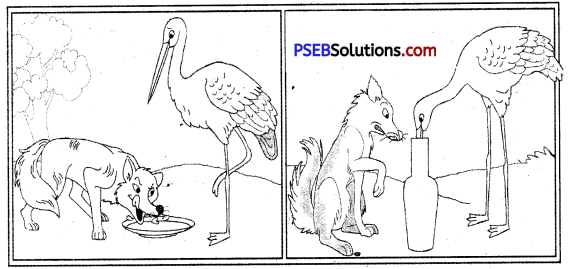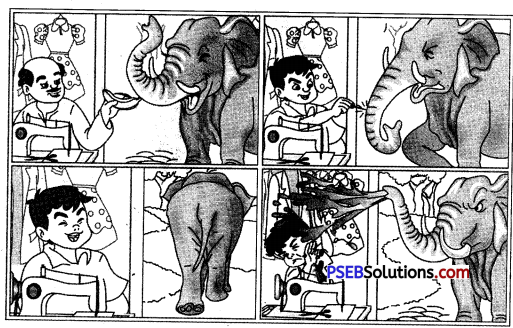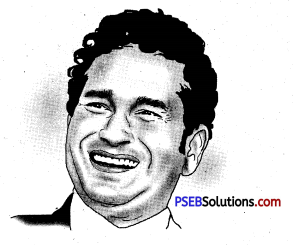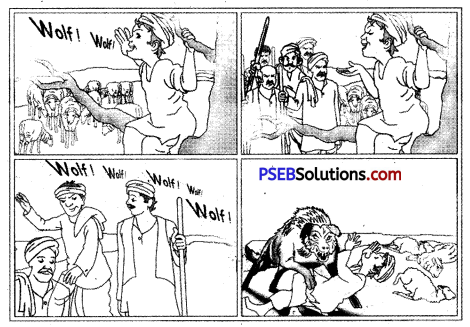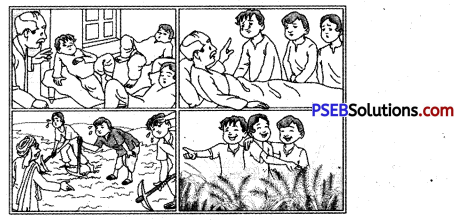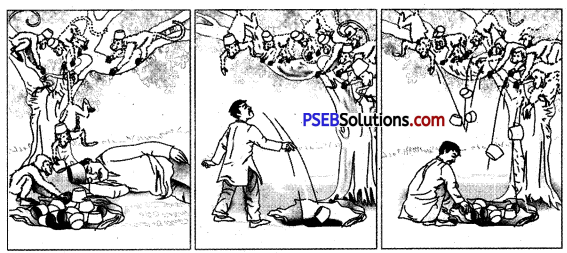Punjab State Board PSEB 12th Class Hindi Book Solutions Chapter 7 सुमित्रानन्दन पंत Textbook Exercise Questions and Answers.
PSEB Solutions for Class 12 Hindi Chapter 7 सुमित्रानन्दन पंत
Hindi Guide for Class 12 PSEB सुमित्रानन्दन पंत Textbook Questions and Answers
(क) लगभग 40 शब्दों में उत्तर दें:
प्रश्न 1.
‘दो लड़के’ कविता के प्रतिपाद्य को अपने शब्दों में लिखो।
उत्तर:
प्रस्तुत कविता कवि की एक प्रगतिवादी रचना है, जिसमे कवि ने मानवतावादी दृष्टिकोण अभिव्यक्त करते हुए मनुष्य को ही ईश्वर मानते हुए उसे धरती पर ही स्वर्ग बसाने के लिए कहा है, जिससे मनुष्य आपस में प्रेम प्यार से रहते हुए अपनी सभी इच्छाओं की पूर्ति कर सके। कोई भेदभाव न रहे, किसी का शोषण न हो, मानवीयता का प्रचार हो।
प्रश्न 2.
‘दो लड़के’ कविता का सार अपने शब्दों में लिखो।
उत्तर:
दो लड़के’ शीर्षक कविता पंत जी की काव्यकृति ‘युगवाणी’ में संकलित है। प्रस्तुत कविता में कवि ने अपनी मानवतावादी दृष्टिकोण को अभिव्यक्त किया है। कविता के आरम्भ में कवि ने यथार्थ का चित्रण करते हुए दो निर्धन निम्न जाति के नंग-धडंग किन्तु सुन्दर गठीले शरीर वाले लड़कों का वर्णन किया है बाद में कविं आत्मा की एकान्तिक उपासना को भौतिक शरीर के सामने नगण्य मानता हुआ कहता है कि संसार में रहने का सबसे अधिक अधिकार उसे है जो अधिक दुर्बल है। संसार में रहने के लिए मनुष्य को उपयुक्त साधनों की आवश्यकता है। मनुष्य एक-दूसरे को मानव-सुलभ प्रेमदान देता हुआ धरती पर स्वर्ग स्थापित कर सके।

प्रश्न 3.
‘सुख-दुःख’ में कवि ने सुख और दुःख को क्या-क्या उपमाएँ दी हैं ? स्पष्ट करें।
उत्तर:
कवि ने सुख और दुःख को आँख-मिचौनी का खेल कहा है। कवि ने सुख और दुःख को उषा और सन्ध्या, मिलन और विरह, आँसू और हँसी तथा चाँद और बादलों से उपमा दी है।
प्रश्न 4.
‘सुख-दुःख’ कविता से हमें क्या शिक्षा मिलती है ?
उत्तर:
प्रस्तुत कविता से हमें यह शिक्षा मिलती है कि दुःख या सुख का निरन्तर रहना भी कष्टकारक होता है। अतः हमें सुख-दुःखों को आपस में बाँट लेना चाहिए ताकि जीवन में सन्तुलन बना रह सके।
(ख) सप्रसंग व्याख्या करें:
प्रश्न 5.
सुन्दर लगती नग्न देह ………….. सच्चे।
उत्तर:
कवि उन दो निर्धन लड़कों की दीन-हीन दशा का चित्रण करते हुए कहता है कि उन लड़कों का नंगा शरीर सुन्दर लगता है जो व्यक्ति के मन और आँखों को मोह लेता है। मनुष्यता के नाते व्यक्ति के हृदय में अपनापन भर जाता है। ये पासी के बच्चे भी तो मनुष्य के ही बालक हैं। उनका रोम-रोम मनुष्य के सच्चे साँचे में ढला हुआ है।
प्रश्न 6.
यह साँझ उषा का आँगन …….. जीवन का।
उत्तर:
कवि कहते हैं कि यह संसार सन्ध्या और उषा का आँगन है अर्थात् यहाँ सन्ध्या रूपी दुःख भी है तो उषा रूपी सुख भी है। यहाँ विरह और मिलन का मिलाप होता है अर्थात् संसार में लोग मिलते भी हैं और बिछुड़ते भी हैं। इस तरह वे मिलन के सुख और बिछुड़ने के दुःख को झेलते हैं। मनुष्य के जीवन में हँसी भी है और आँसू भी हैं। उसे सुख-दुःख दोनों ही भोगने पड़ते हैं। यही मानव जीवन है।
PSEB 12th Class Hindi Guide सुमित्रानन्दन पंत Additional Questions and Answers
अति लघुत्तरात्मक प्रश्न
प्रश्न 1.
सुमित्रानंदन पंत का जन्म कब और कहाँ हुआ था?
उत्तर:
पंत जी का जन्म अल्मोड़ा जिले के कौसानी नामक गांव में 21 मई, सन् 1900 ई० में हुआ था।
प्रश्न 2.
पंत जी को ‘चिदंबरा’ पर कौन-सा पुरस्कार प्राप्त हुआ था?
उत्तर:
भारतीय ज्ञानपीठ पुरस्कार।।

प्रश्न 3.
पंत जी को डी० लिट् की उपाधि किस विश्वविद्यालय ने दी थी?
उत्तर:
कलकत्ता विश्वविद्यालय ने।
प्रश्न 4.
पंत जी का देहांत कब हुआ था?
उत्तर:
सन् 1977 ई० में।
प्रश्न 5.
दो निर्धन बालक प्रायः कहां आ जाते थे?
उत्तर:
लेखक के टीले पर बने घर के आंगन में।
प्रश्न 6.
दोनों बालक कवि को प्रतीत होते थे?
उत्तर:
सांवले रंग की मूर्ति की तरह, साँवले और चुस्त।
प्रश्न 7.
दोनों बालक किसकी तरह किलकारियां मारा करते थे?
उत्तर:
बंदर की तरह।
प्रश्न 8.
उन दोनों बच्चों की लगभग आयु कितनी थी?
उत्तर:
छः सात वर्ष।
प्रश्न 9.
कवि ने समाज में रहने वाले सभी लोगों को कैसा माना है?
उत्तर:
भेदभाव से रहित-पूरी तरह से एक समान।
प्रश्न 10.
कवि जीवन में सदा किसकी खेल-मिचौली देखना चाहता था?
उत्तर:
सुख-दुःख की खेल-मिचौली।
प्रश्न 11.
अधिक सुख और दुःख से यह जंग कैसा लगता है?
उत्तर:
पीड़ित।
प्रश्न 12.
कवि ने इस संसार को किसका आँगन माना है?
उत्तर:
सांझ-उषा का आँगन।
वाक्य पूरे कीजिए
प्रश्न 13.
सुंदर लगती नग्न देह,…………
उत्तर:
मोहती नयन मन।
प्रश्न 14.
जग का अधिकारी है वह,……………….।
उत्तर:
जो है दुर्बलतर।।

प्रश्न 15.
निष्ठुर है जड़ प्रकृति…………………।
उत्तर:
सहज भंगुर जीवित जन।
प्रश्न 16.
मानव का साम्राज्य बने,………
उत्तर:
मानव-हित निश्चय।।
प्रश्न 17.
जग पीड़ित है अति दुःख से,………….
उत्तर:
जग-पीड़ित रे अति-सुख से।
प्रश्न 18.
दुख-सुख की निशा-दिवा में….
उत्तर:
सोता-जगता जग जीवन।
हाँ-नहीं में उत्तर दीजिए
प्रश्न 19.
‘दो लड़के’ एक प्रगतिवादी कविता है।
उत्तर:
हाँ।
प्रश्न 20.
दो लड़के पल्लव में संकलित है।
उत्तर:
नहीं।
प्रश्न 21.
कवि जीवन में चिर सुख-चिर दुख चाहता था।
उत्तर:
हाँ।
बोर्ड परीक्षा में पूछे गए प्रश्न
प्रश्न 1.
कवि पंत का पूरा नाम लिखिए।
उत्तर:
सुमित्रानंदन पंत।
बहुविकल्पीय प्रश्नोत्तर
1. हिंदी साहित्य का सर्वप्रथम ज्ञानपीठ पुरस्कार किसको मिला ?
(क) सुमित्रानंदन पंत
(ख) निराला
(ग) महादेवी वर्मा
(घ) प्रसाद
उत्तर:
(क) सुमित्रानंदन पंत
2. सुमित्रानंदन पंत को भारत सरकार ने किस सम्मान से अलंकृत किया ?
(क) पद्मविभूषण
(ख) पद्मभूषण
(ग) ज्ञानपीठ
(घ) भारत रत्न।
उत्तर:
(ख) पद्मभूषण

3. सुमित्रानंदन पंत को किस कृति पर ज्ञानपीठ पुरस्कार मिला ?
(क) चिदंबरा
(ख) चितकोबरा
(ग) ऋतंबरा
(घ) ऋतुम्बर
उत्तर:
(क) चिदंबरा
4. कवि ने संसार को किसका आंगन माना है ?
(क) सांझ का
(ख) ऊषा का
(ग) सांझ-ऊषा का
(घ) रात का।
उत्तर:
(ग) सांझ-ऊषा का
5. ‘दो लड़के’ कैसी कविता है ?
(क) प्रगतिवादी
(ख) प्रयोगवादी
(ग) छायावादी
(घ) हालावादी।
उत्तर:
(क) प्रगतिवादी
सुमित्रानन्दन पंत सप्रसंग व्याख्या
दो लड़के कविता का सार
‘दो लड़के’ कविता में कवि ने दो निर्धन नाटे, सांवले, मांसल, नंगे तन, छ:सात साल के लड़कों के फुर्तीलेपन, मामूली-सी वस्तुएं प्राप्त करके भी प्रसन्न हो जाने का वर्णन किया है। उन्हें अपने अभावग्रस्त जीवन में भी आनन्द की अनुभूति होती है, वे इस अभाव से चिन्तित नहीं हैं। कवि के मन में उनके प्रति अपनापन जाग उठता है। वह चाहता है कि ये बालक भी मानव की सन्तान हैं। इसलिए मानव-मात्र में कोई भेदभाव न रहे। मानव का कल्याण हो, शोषण न हो। सब परस्पर प्रेमभाव से रहें। सब की इच्छाएं पूर्ण हों तथा धरती पर ही स्वर्ग बन जाए।
1. मेरे आंगन में, टीले पर है मेरा घर,
दो छोटे-से लड़के आ जाते हैं अक्सर,
नंगे-तन, गदबदे, साँवले, सहज छबीले
मिट्टी के मटमैले पुतले -पर फुर्तीले।
कठिन शब्दों के अर्थ:
अक्सर = प्रायः । गदबदे = कोमल, भरे हुए शरीर वाले। सहज = स्वाभाविक रूप से। छबीले = सुन्दर, संजीला। पुतला = मूर्ति। फुर्तीला = चुस्त।।
प्रसंग:
प्रस्तुत पद्यांश आधुनिक युग के प्रसिद्ध छायावादी कवि सुमित्रानन्दन पन्त द्वारा लिखित कविता ‘दो लड़के’ में से लिया गया है। यह कविता कवि की काव्यकृति ‘युगवाणी’ में संकलित है। प्रस्तुत कविता में कवि प्रगतिवादी बन कर समाज के दो असहाय एवं पीड़ित बालकों का चित्रण करते हुए अपने मानवतावादी दृष्टिकोण को व्यक्त कर रहे हैं।
व्याख्या:
कवि अपने आँगन में आने वाले दो निर्धन बालकों का चित्रण करते हुए कहता है कि टीले पर बने मेरे घर के आँगन में दो छोटे-से लड़के प्रायः आ जाते हैं। वे शरीर से नंगे होते हैं, किन्तु भरे हुए शरीर वाले, साँवले रंग के स्वाभाविक रूप से सुन्दर दिखते हैं। वे मिट्टी से लथपथ होते हैं उन्हें देखकर ऐसा लगता है कि वे कोई मिट्टी की मूर्ति हो परन्तु हैं बड़े ही चुस्त अर्थात् वे हर काम बड़ी चुस्ती-फुर्ती से करते हैं।
विशेष:
- कवि ने अपने आंगन में आकर खेलने वाले दो बालकों का सजीव चित्रण किया है।
- भाषा तत्सम, तद्भव, देशज शब्दों से युक्त भावपूर्ण है।
- अनुप्रास तथा उत्प्रेक्षा अलंकार है।
2. जल्दी से, टीले के नीचे, उधर उतर कर
वे चुन ले जाते कूड़े से निधियाँ सुन्दर
सिगरेट के खाली डिब्बे, पन्नी चमकीली
फीतों के टुकड़े, तस्वीरें नीली पीली
मासिक-पत्रों के कवरों की, और बन्दर से
किलकारी भरते हैं, खुश हो-हो अन्दर से।
दौड़ पार आँगन के फिर हो जाते ओझल
वे नाटे छ:-सात साल के लड़के मांसल।
कठिन शब्दों के अर्थ:
टीला = छोटी पहाड़ी, ऊँची जगह । निधियाँ = खज़ाने। पन्नी = चमकीला कागज़ जो सिगरेट की डिबिया में होता है! कवर = मुख्य पृष्ठ। किलकारी भरना = खुशी से ऊँची आवाज़ में चीखना। नाटे = छोटे कद के। मांसल = पुष्ट शरीर वाले तगड़े।
प्रसंग:
प्रस्तुत काव्यांश सुमित्रानन्दन पंत द्वारा रचित कविता ‘दो लड़के’ से लिया गया है। इसमें कवि ने निर्धन वर्ग के दो नंग-धडंग छ:-सात वर्षीय बालकों की अभावों में भी मस्त रहने की दशा का चित्रण करते हुए उनके प्रति मानवीय संवेदना जगाने का प्रयास किया है।
व्याख्या:
अपने घर के आँगन में प्रायः आने वाले दो निर्धन किन्तु सुन्दर लड़कों का वर्णन करता हुआ कवि कहता है कि वे लड़के जल्दी से टीले के नीचे दूसरी तरफ उतर कर कूड़े से अपने लिए खज़ाना समझते हुए कुछ चीजें चुनकर ले जाते थे। जैसे कि सिगरेट के खाली डिब्बे, चमकीली पन्नी, बूटों के फीतों के टुकड़े और मासिक पत्रों के मुख्य पृष्ठों की नीली-पीली रंगीन तस्वीरें। इन चीजों को पाकर वे अन्दर से खुश हो-होकर बन्दरों के समान किलकारियाँ भरते हैं और आँगन को दौड़ कर पार कर आँखों से ओझल हो जाते हैं। वे छोटे कद के पुष्ट शरीर वाले छ: सात साल के लड़के
विशेष:
- कवि मानता है कि वे निर्धन बालक छोटी-छोटी चीजें पाकर भी प्रसन्न होते हैं। उन्हें अपनी निर्धनता या अभाव भरे जीवन की कोई चिन्ता नहीं है।
- भाषा सहज, तद्भव एवं देशज शब्दों से युक्त चित्रात्मक है।
- अनुप्रास तथा उपमा अलंकार हैं।

3. सुन्दर लगती नग्न देह, मोहती नयन-मन,
मानव के नाते उर में भरता अपनापन।
मानव के बालक हैं ये पासी के बच्चे,
रोम-रोम मानव, साँचे में ढाले सच्चे।
कठिन शब्दों के अर्थ:
पासी = एक जाति। उर = हृदय।
प्रसंग:
यह काव्यांश सुमित्रानन्दन पंत द्वारा रचित कविता ‘दो लड़के’ से उद्धृत है। इसमें कवि ने निर्धन वर्ग के दो नंग-धडंग छ:-सात वर्षीय बालकों की अभावों में भी मस्त रहने की दशा का चित्रण करते हुए उनके प्रति मानवीय संवेदना जगाने का प्रयास किया है।
व्याख्या:
कवि उन दो निर्धन लड़कों की दीन-हीन दशा का चित्रण करते हुए कहता है कि उन लड़कों का नंगा शरीर सुन्दर लगता है जो व्यक्ति के मन और आँखों को मोह लेता है। मनुष्यता के नाते व्यक्ति के हृदय में अपनापन भर जाता है। ये पासी के बच्चे भी तो मनुष्य के ही बालक हैं। उनका रोम-रोम मनुष्य के सच्चे साँचे में ढला हुआ है।
विशेष:
- कवि के अनुसार वे दोनों लड़के निम्न और निर्धन जाति के होते हुए भी मानव के बच्चे होने के कारण सुन्दर प्रतीत होते हैं। उन्हें देखकर उसके मन में उनके प्रति अपनापन जागता है। कवि ने इन बालकों की चिन्तामुक्त दशा का वर्णन करते हुए इनके प्रति सद्भाव व्यक्त किया है।
- भाषा तत्सम प्रधान परन्तु सरल तथा भावपूर्ण है।
- अनुप्रास तथा पुनरुक्ति प्रकाश अलंकार है।
4. अस्थि-माँस के इन जीवों का ही यह जग घर,
आत्मा का अधिवास न यह, वह सूक्ष्म अनश्वर !
न्योछावर है आत्मा नश्वर रक्त-मॉस पर,
जग का अधिकारी है वह, जो है दुर्बलतर !
कठिन शब्दों के अर्थ:
अस्थि-माँस = हड्डियाँ और माँस। जीव = प्राणी। अधिवास = रहने का स्थान। नश्वर = नाशवान्। दुर्बलतर = अत्यन्त कमज़ोर।
प्रसंग:
प्रस्तुत काव्यावतरण सुमित्रानन्दन पंत द्वारा रचित कविता ‘दो लड़के’ से अवतरित है। इसमें कवि ने दो निर्धन नंगधडंग बालकों के प्रति अपनी संवेदना व्यक्त की है।
व्याख्या:
कवि अपने मानवतावादी दृष्टिकोण को अभिव्यक्त करता हुआ कहता है कि यह संसार हाड़ मांस के प्राणियों का ही घर है। यह संसार आत्मा के रहने की जगह नहीं है क्योंकि आत्मा तो सूक्ष्म और न नाश होने वाली अर्थात् अमर है जबकि संसार की प्रत्येक वस्तु तो स्थूल और अनित्य है। कवि कहता है कि इस न नष्ट होने वाली-अमर आत्मा पर यह नाशवान् रक्त माँस का पुतला मानव न्योछावर है तात्पर्य यह है कि इस नाशवान् हाड़-माँस के पुतले मानव के सामने अनश्वर आत्मा क्षुद्र है। इस नाशवान संसार में रहने का वही अधिकारी है जो अत्यन्त कमज़ोर भी है तात्पर्य यह है कि निर्धन, कमज़ोर लोग भी इस संसार में रहने का अधिकार रखते हैं।
विशेष:
- कवि आत्मा की एकान्तिक उपासना को भौतिक शरीर के सामने नगण्य मानता है। कवि के लिए पूर्ण मानव ही ईश्वर है।
- भाषा सहज, सरल, देशज-तत्सम शब्दों से युक्त भावपूर्ण है।
- अनुप्रास अलंकार तथा चित्रमयता है।
5. वह्नि बाढ़, उल्का, झंझा की भीषण भू पर
कैसे रह सकता है कोमल मनुज कलेवर?
निष्ठुर है जड़ प्रकृति, सहज भंगुर जीवित जन,
मानव को चाहिए यहाँ मनुजोचित साधन !
कठिन शब्दों के अर्थ:
वह्नि = आग। उल्का = तारों का टूट कर धरती पर गिरना। झंझा = तूफान। भीषण = भयानक । कलेवर = शरीर। निष्ठुर = निर्दय, कठोर। जड़ = बेजान। सहज भंगुर = आसानी से या स्वाभाविक रूप से नष्ट होने वाला। मनुजोचित = मनुष्य के लिए उचित। साधन = तरीका।
प्रसंग:
प्रस्तुत काव्य-खंड सुमित्रानन्दन पंत द्वारा रचित कविता ‘दो लड़के’ से अवतरित है। इसमें कवि ने दो निर्धन नंगधडंग बालकों के प्रति अपनी संवेदना व्यक्त की है।
व्याख्या:
कवि संसार की भीषणता का उल्लेख करता हुआ मनुष्य को जीने के लिए उचित साधन होने की चर्चा करता हुआ कहता है कि इस संसार में आग का डर है बाढ़ का उत्पीड़न है अर्थात् बाढ़ आकर दु:खी करती है। तारों के टूट कर धरती पर गिरने का भय है। यहाँ इस धरती पर भयंकर तूफान आते रहते हैं फिर भला कोमल शरीर वाला मनुष्य इस धरती पर या इस संसार में कैसे रह सकता है। बेजान प्रकृति भी बड़ी निर्दयी है और जीवन सहज ही नाश हो जाने वाला है। अतः इस संसार में रहने के लिए मनुष्य को उचित साधनों की आवश्यकता है।
विशेष:
- परोक्ष रूप में कवि प्रकृति द्वारा भी-आग, बाढ़, उल्कापात और तूफान द्वारा ग़रीबों को सताए जाने की बात कह रहा है और समाज से यह आशा करता है कि वह पिछड़ों और ग़रीबों के लिए भी जीने के उचित साधन जुटाए।
- तत्सम प्रधान भाषा में उपदेशात्मकता है।
- प्रश्न तथा अनुप्रास अलंकार तथा चित्रात्मकता का गुण है।
6. क्यों न एक हों मानव मानव सभी परस्पर
मानवता निर्माण करें जग में लोकोत्तर ?
जीवन का प्रासाद उठे भू पर गौरवमय,
मानव का साम्राज्य बने, मानव-हित निश्चय।
कठिन शब्दों के अर्थ:
परस्पर = आपस में। लोकोत्तर = अलौकिक । प्रासाद = महल। मानव-हित = मनुष्य की भलाई के लिए।
प्रसंग:
प्रस्तुत काव्यांश सुमित्रानन्दन पंत द्वारा रचित कविता ‘दो लड़के’ से उद्धृत है। इसमें कवि ने दो निर्धन बालकों के चिन्तामुक्त जीवन का चित्रण करते हुए मानव मात्र के परस्पर मिलजुल कर तथा भेदभाव से रहित समाज बनाकर रहने की प्रेरणा दी है।
व्याख्या:
कवि भेदभाव भरे, अमीर-गरीब का भेद रखने वाले इस संसार को बदलने का प्रयत्न करने के लिए कहता है कि क्यों न सभी मनुष्य आपस में मिलकर संसार में एक अलौकिक मानवता का निर्माण करें, जिससे पृथ्वी पर जीवन का गौरवशाली महल खड़ा किया जा सके और मनुष्य की भलाई के लिए मनुष्य का एक साम्राज्य बन जाए।
विशेष:
- कवि का तात्पर्य यह है कि इस संसार से अमीर-ग़रीब का भेद मिट जाना चाहिए। यह न हो कि एक तो आनन्द से जीवन व्यतीत करे और दूसरा पेट भर रोटी को भी तरसें, इसलिए हमें इस भेदभाव को मिटा कर समता की भावना युक्त संसार का निर्माण करना चाहिए।
- तत्सम प्रधान भाषा में प्रवाह तथा भावों का सुन्दर समन्वय है।
- अनुप्रास, प्रश्न तथा रूपक अलंकार है।
7. जीवन की क्षण-धूलि रह सके जहाँ सुरक्षित,
रक्त-माँस की इच्छाएँ जन की हों पूरित।
मनुज प्रेम से जहाँ रह सकें-मानव ईश्वर।
और कौन-सा स्वर्ग चाहिए तुझे धरा पर ?
कठिन शब्दों के अर्थ:
पूरित = पूरी।
प्रसंग:
प्रस्तुत काव्यावतरण सुमित्रानन्दन पंत द्वारा रचित कविता ‘दो लड़के’ से अवतरित है। इसमें कवि ने दो निर्धन बालकों के चिन्तामुक्त जीवन का चित्रण करते हुए मानव मात्र के परस्पर मिलजुल कर तथा भेदभाव से रहित समाज बनाकर रहने की प्रेरणा दी है।
व्याख्या:
कवि धरती को ही स्वर्ग बनाने की कामना करते हुए कहता है कि हमें ऐसे संसार का निर्माण करना होगा जहाँ इस क्षणिक जीवन की मिट्टी सुरक्षित रह सके। प्रत्येक मनुष्य की इच्छाएं पूरी हो सकें। मनुष्य एक-दूसरे से प्रेमपूर्वक रह सके। हे मनुष्य रूपी ईश्वर ! तुझे धरती पर फिर किस दूसरे स्वर्ग की कामना होगी.? मनुष्य का साम्राज्य ही तुम्हारा स्वर्ग होगा अर्थात् जिस प्रकार स्वर्ग में सभी सुख सुविधाएँ प्राप्त हैं, धरती पर भी वे सब प्राप्त होगी तो धरती स्वर्ग कहलाएगी।
विशेष:
- कवि का तात्पर्य यह है कि मनुष्य मनुष्य से प्रेम करके अपनी सभी इच्छाओं को पूरी कर सकता है तथा धरती को स्वर्ग बना सकता है।
- भाषा तत्सम प्रधान तथा भावपूर्ण है।
- प्रश्न अलंकार है।
सुख-दुःख कविता का सार
‘सुख-दुःख’ कविता में कवि ने सदा के लिए न सुख चाहा है और न ही दुःख। कवि का मानना है कि सुख-दुःख के मधुर मिलन में ही जीवन की परिपूर्णता है। अत्यधिक सुख अथवा दुःख से लोग परेशान हो जाते हैं। सुख और दुःख का संगम ही उचित है। जैसे रात के बाद दिन अच्छा लगता है, वैसे ही दुःख के बाद सुख में आनन्द आता है। दुःख-सुख तो विरह के बाद मिलन में सुख के समान है। इस कविता में कवि ने सुख-दुःख से सम्बन्धित अपनी दाशनिक मान्यताओं को व्यक्त किया है।
1. मैं नहीं चाहता चिर-सुख,
मैं नहीं चाहता चिर-दुःख,
सुख-दुःख की खेल-मिचौनी,
खोले जीवन अपना मुख।
कठिन शब्दों के अर्थ:
चिर = देर तक रहने वाला। खेल-मिचौनी = आँख मिचौनी का खेल। खोले जीवन अपना मुख = जीवन अग्रसर हो।
प्रसंग:
प्रस्तुत पद्यांश आधुनिक युग के प्रसिद्ध छायावादी कवि सुमित्रानन्दन पन्त की काव्यकृति ‘गुंजन’ में संकलित ‘सुख-दुःख’ शीर्षक कविता में से लिया गया है। प्रस्तुत कविता में कवि जीवन में सुख-दुःख की समानता होने की कामना करते हैं क्योंकि निरन्तर दुःख हो या सुख सदा मनुष्य को दुःखी करते हैं।
व्याख्या:
कवि कहते हैं कि मैं यह भी नहीं चाहता कि सुख देर तक मेरे जीवन में बना रहे और मैं यह भी नहीं चाहता दुःख देर तक मेरे जीवन में बना रहे। मैं तो यह चाहता हूँ कि मेरे जीवन में, सुख-दुःख आँख-मिचौनी का खेल । खेलते रहें अर्थात् सुख-दुःख मेरे जीवन में आते जाते रहें इस तरह मेरा जीवन चलता रहे।
विशेष:
- कवि का मानना है कि सुख-दुःख रथ के पहिये के समान हों कभी पहिए का एक भाग ऊपर आ जाए तो कभी दूसरा। सदा सुख या सदा दुःख बना रहने पर जीवन रुक जाएगा। आँख-मिचौनी के खेल में कभी एक छिपता है तो कभी दूसरा। इसी प्रकार जीवन में भी कभी सुख छिप जाए दूर हो जाए तो कभी दुःख। यही जीवन है।
- तत्सम प्रधान सहज भाषा का प्रयोग किया गया है।
- अनुप्रास अलंकार तथा लाक्षणिकता विद्यमान है।

2. सुख-दुःख के मधुर मिलन से
यह जीवन हो परिपूरन,
फिर घन में ओझल हो शशि
फिर शशि से ओझल हो घन
कठिन शब्दों के अर्थ:
मिलन = संयोग। ओझल होना = छिप जाना।
प्रसंग:
प्रस्तुत पंक्तियाँ सुमित्रानन्दन पंत द्वारा रचित कविता ‘सुख-दुःख’ से ली गई हैं, जिसमें कवि ने सुख-दुःख को समभाव से ग्रहण करने की प्रेरणा दी है।
व्याख्या:
कवि कहते हैं कि सुख और दुःख के उचित संयोग से मेरा जीवन पूर्ण हो अर्थात् जीवन में सुख-दुःख आते जाते रहने चाहिए जैसे कभी बादलों में चाँद छिप जाए और कभी बादल चाँद से दूर हो जाएँ।
विशेष:
- चाँद सुख का प्रतीक माना जाता है और बादल दुःख के।
- भाषा तत्सम प्रधान लाक्षणिक से युक्त है।
- अनुप्रास तथा मानवीकरण अलंकार हैं।
3. जग पीड़ित है अति दुःख से,
जग पीड़ित रे अति-सुख से,
मानव-जग में बँट जावें
दुःख सुख से औ, सुख दुःख से।
कठिन शब्दों के अर्थ:
पीड़ित = दु:खी। अति = अत्यधिक।
प्रसंग:
प्रस्तुत पंक्तियाँ सुमित्रानन्दन पंत द्वारा रचित कविता ‘सुख-दुःख’ से ली गई हैं, जिसमें कवि ने सुख-दुःख को समभाव से ग्रहण करने की प्रेरणा दी है।
व्याख्या:
कवि कहता है कि संसार दुःख की अधिकता से भी दु:खी है और सुख की अधिकता से भी दुःखी है अर्थात् मनुष्य निरन्तर दुःख या विपत्तियाँ सहता-सहता भी दुःखी हो जाता है और मनुष्य सुख के निरन्तर बने रहने से भी ऊब जाता है। इसलिए वह चाहता है कि मानव जगत् में दुःख-सुख से और सुख-दुःख से बँट जाएँ अर्थात् दुःखी मनुष्य के दुःखों को सुखी मनुष्य बाँट लें और सुखी मनुष्य के थोड़े सुख दुःखी मनुष्यों में बँट जाएँ। इस तरह जीवन में सुख-दुःख का सन्तुलन बना रहेगा।
विशेष:
- कवि ने सुख-दुःख के बराबर बँटवारे की कामना की है। सुखी व्यक्ति दुःखियों के दुःख को दूर करें।
- भाषा तत्सम प्रधान तथा भावपूर्ण है।
- कवि ने सुख-दुःख को समभाव से स्वीकार करने पर बल दिया है।
4. अविरत दुःख है उत्पीड़न
अविरत सुख भी उत्पीड़न
सुख-दुःख की निशा-दिवा में
सोता-जगता जग-जीवन।
कठिन शब्दों के अर्थ:
अविरत = निरन्तर, लगातार। उत्पीड़न = दुःख का कारण। दिवा = दिन।
प्रसंग:
प्रस्तुत पंक्तियाँ सुमित्रानन्दन पंत द्वारा रचित कविता सुख-दुःख से लगी गई हैं, जिसमें कवि ने सुख-दुःख . में समन्वय पर बल दिया है।
व्याख्या:
कवि कहते हैं कि निरन्तर दुःख भी दुःख का कारण बनता है अर्थात् मनुष्य को व्यथित कर देता है और निरन्तर सुख भी दुःख पैदा करने का कारण बनता है अर्थात् लगातार सुख सहते-सहते या भोगते-भोगते मनुष्य उदासीन हो जाता है। इसलिए चाहिए तो यह है कि दुःख-सुख रूपी रात-दिन में मनुष्य जीवन सोता-जागता रहे। क्योंकि लगातार दुःख सहते-सहते मनुष्य व्याकुल हो जाता है और सुख के दिनों में वह उत्सव और उल्लास मनाता है।
विशेष:
- मानव जीवन सुख-दुःख का ही मिश्रण है।
- भाषा तत्सम प्रधान लाक्षणिक है।
- अनुप्रास, रूपक तथा मानवीकरण अलंकार हैं।
5. यह साँझ-उषा का आँगन,
आलिंगन विरह-मिलन का,
चिर हास-अश्रुमय आनन ।
रे इस मानव-जीवन का।
कठिन शब्दों के अर्थ:
आलिंगन = मिलाप। विरह = जुदाई, बिछुड़ना। आनन = चेहरा, मुख। ..
प्रसंग:
प्रस्तुत पंक्तियाँ सुमित्रानन्दन पंत द्वारा रचित कविता ‘सुख-दुःख’ से ली गई हैं, जिसमें कवि ने सुख-दुःख में समन्वय पर बल दिया है।
व्याख्या:
कवि कहते हैं कि यह संसार सन्ध्या और उषा का आँगन है अर्थात् यहाँ सन्ध्या रूपी दुःख भी है तो उषा रूपी सुख भी है। यहाँ विरह और मिलन का मिलाप होता है अर्थात् संसार में लोग मिलते भी हैं और बिछुड़ते भी हैं। इस तरह वे मिलन के सुख और बिछुड़ने के दुःख को झेलते हैं। मनुष्य के जीवन में हँसी भी है और आँसू भी हैं। उसे सुख-दुःख दोनों ही भोगने पड़ते हैं। यही मानव जीवन है।
विशेष:
- कवि ने सुख-दुःख के समन्वय पर बल दिया है।
- भाषा तत्सम प्रधान एवं लाक्षणिक है।
- रूपक और मानवीकरण अलंकार हैं।
सुमित्रानन्दन पंत Summary
सुमित्रानन्दन पंत जीवन परिचय
सुमित्रानन्दन पन्त जी का जीवन परिचय दीजिए ।
सुमित्रानन्दन पन्त जी का जन्म अल्मोड़ा जिले के कौसानी नामक गाँव में 21 मई, सन् 1900 ई० को हुआ। इनके पिता का नाम पंडित गंगादत्त तथा माता का नाम सरस्वती था। इन्होंने प्रारम्भिक शिक्षा अल्मोड़ा तथा बनारस में प्राप्त की थी तथा उच्च शिक्षा के लिए प्रयाग के म्योर सैंट्रल कॉलेज में प्रवेश लिया, किन्तु महात्मा गाँधी के असहयोग आन्दोलन से प्रभावित होकर पढ़ाई छोड़ दी और साहित्य साधना करने लगे। इन्होंने आकाशवाणी, इलाहाबाद में भी कार्य किया था। इन्हें भारत सरकार ने पद्मभूषण से, कलकत्ता विश्वविद्यलय ने डी० लिट् से, साहित्य अकादमी ने ‘कला और बूढ़ा चाँद’ पर सोवियत भूमि नेहरू पुरस्कार तथा भारतीय ज्ञानपीठ ने ‘चिदम्बरा’ पर सम्मानित किया था। सन् 1977 में इनका देहान्त हो गया था। इन्होंने कविता, नाटक, उपन्यास, कहानियां, निबन्ध आदि सभी लिखे हैं। इनकी प्रमुख रचनाएँ वीणा, पल्लव, गुंजन, युगान्त, ग्राम्या, लोकायतन, चिदंबरा, कला और बूढ़ा चांद हैं।
![]()
![]()
![]()
